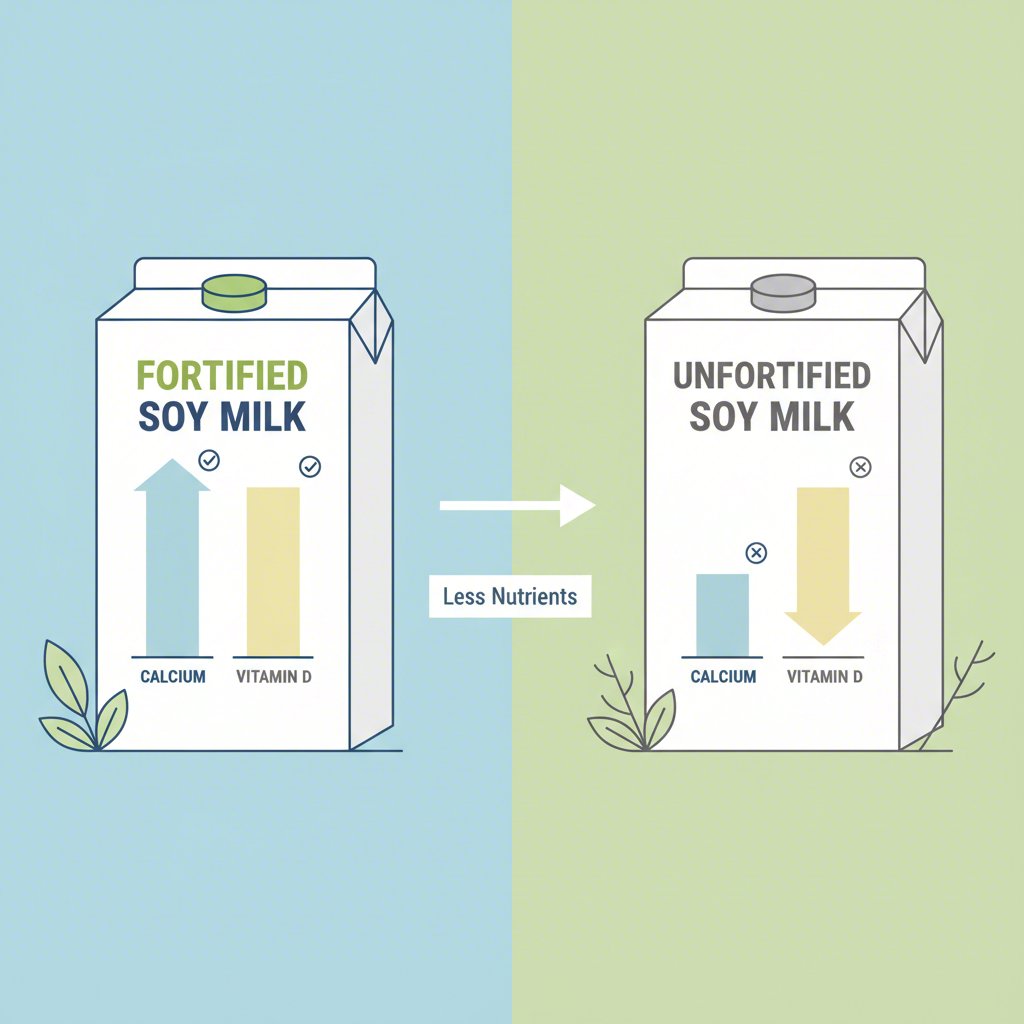TL;DR
The primary difference between fortified and unfortified soy milk lies in added nutrients. Fortified soy milk is enriched with vitamins and minerals, primarily calcium and vitamin D, to make its nutritional profile comparable to cow’s milk. Unfortified soy milk, on the other hand, contains only the nutrients naturally present in soybeans, such as high-quality protein, potassium, and certain B vitamins.
The Key Difference: Understanding Fortification
When you’re standing in the dairy aisle comparing plant-based milks, the term “fortified” is one of the most important distinctions to understand. Fortification is the process of adding essential vitamins and minerals to a food product that are not naturally present in significant amounts. In the case of soy milk, this process is crucial for consumers who use it as a primary replacement for dairy milk.
The main reason for fortifying soy milk is to help it achieve a nutritional profile similar to cow’s milk. According to the U.S. Food and Drug Administration (FDA), dairy products are a major source of key nutrients like calcium, vitamin D, and potassium in the American diet. To serve as a viable alternative, manufacturers enrich soy milk to ensure consumers don’t miss out on these vital compounds, particularly those crucial for bone health. In fact, the Dietary Guidelines for Americans only include soy beverages fortified with calcium, vitamin A, and vitamin D in the dairy group because of this nutritional similarity.
The most common nutrients added to soy milk include:
- Calcium: Essential for building and maintaining strong bones and teeth.
- Vitamin D: Crucial for helping the body absorb calcium and supporting immune function.
- Vitamin B12: Important for nerve function and the formation of red blood cells, this vitamin is naturally found almost exclusively in animal products, making fortification vital for vegans.
So why would someone choose unfortified soy milk? Some individuals prefer foods with fewer additives and a more “natural” ingredient list. If their diet is already rich in calcium and vitamin D from other sources like leafy greens, supplements, or other foods, they may not need the extra nutrients from their soy milk. To know which you’re buying, always check the nutrition label and ingredients list. Fortified products will clearly list the added vitamins and minerals.
Nutritional Showdown: Fortified vs. Unfortified Soy Milk
The nutritional gap between fortified and unfortified soy milk is significant, especially when it comes to micronutrients. While both versions offer the benefits of soy—a complete protein containing all nine essential amino acids—fortification dramatically alters the beverage’s role in a balanced diet. Unfortified soy milk is a good source of natural compounds like potassium, but it lacks the calcium and vitamin D that many people expect from a “milk” product.
Fortified soy milk is intentionally engineered to be a nutritional powerhouse, closely mirroring dairy milk. A single glass can provide a substantial portion of the daily recommended intake for calcium and vitamin D, making it an excellent choice for maintaining bone density. However, it’s worth noting that soy contains a natural compound called phytate, which can slightly inhibit the body’s ability to absorb all the available calcium. Despite this, fortified soy milk remains one of the best non-dairy calcium sources available.
To illustrate the differences, here is a side-by-side comparison based on typical values for an 8-ounce (240ml) serving:
| Nutrient | Fortified Soy Milk (Unsweetened) | Unfortified Soy Milk (Unsweetened) | Low-Fat Cow’s Milk (for reference) |
|---|---|---|---|
| Protein | 7-10 grams | 7-10 grams | ~8 grams |
| Calcium | ~300 mg (25-30% DV) | ~60 mg (4-6% DV) | ~300 mg (25-30% DV) |
| Vitamin D | ~120 IU (15% DV) | 0 IU | ~120 IU (15% DV) |
| Vitamin B12 | ~3 mcg (120% DV) | 0 mcg | ~1.2 mcg (50% DV) |
| Calories | ~80-100 kcal | ~80-100 kcal | ~100 kcal |
| Added Sugars | 0 grams | 0 grams | 0 grams (natural sugar is present) |
Note: Values are approximate and can vary by brand. Always check the product’s Nutrition Facts label.
This data clearly shows that while the base protein and calorie content are similar, fortified soy milk is vastly superior for bone-building nutrients. When choosing a product, it’s also critical to check for added sugars, as flavored versions (like vanilla or chocolate) can contain significant amounts, which can detract from the overall health benefits.

Health Implications: Which Soy Milk Is Right for You?
The choice between fortified and unfortified soy milk ultimately depends on your individual diet, health goals, and reasons for choosing a plant-based alternative. There is no single “better” option; the right choice is the one that best complements your overall nutritional intake.
You should consider choosing FORTIFIED soy milk if:
- You are replacing dairy milk: If soy milk is your primary milk source, the fortified version will provide the calcium and vitamin D you would otherwise get from cow’s milk, helping to support bone density.
- You follow a vegan or plant-based diet: Fortified soy milk is an excellent source of vitamin B12, a nutrient that is difficult to obtain from plant sources alone.
- You have a higher risk for osteoporosis: Ensuring adequate intake of calcium and vitamin D is critical for bone health, and fortified soy milk is a reliable way to get both.
You might consider choosing UNFORTIFIED soy milk if:
- Your diet is already rich in key nutrients: If you consistently consume other calcium-rich foods (like fortified tofu, leafy greens) and get enough vitamin D from sunlight or supplements, you may not need the extra fortification.
- You prefer minimally processed foods: For those who prioritize a clean ingredient list and want to avoid additives, unfortified soy milk offers the natural benefits of soybeans without the added vitamins and minerals.
The main disadvantage of unfortified soy milk is its low calcium content, which makes it an unequal replacement for dairy in terms of bone health. For fortified versions, the primary concern is the potential for added sugars in flavored varieties. Always opt for “unsweetened” versions whenever possible to avoid unnecessary calories and sugar intake.

A Practical Guide to Buying Soy Milk
Navigating the plant-based milk aisle can be overwhelming, but knowing what to look for on the label makes the process simple. Whether you choose fortified or unfortified, a few key checks can ensure you’re picking a high-quality product that aligns with your health goals.
When you pick up a carton, head straight for the Nutrition Facts panel and ingredients list. Look for the percentage of Daily Value (% DV) for Calcium and Vitamin D. A fortified product will typically have 25-30% DV for calcium and around 15% DV for vitamin D. Another critical line to check is “Added Sugars.” Unsweetened varieties should list 0 grams. Brands like Silk, a common example, are typically fortified with a range of vitamins, including A, D, B2, and B12, making them a nutritionally robust choice.
For those who prefer complete control over ingredients and want to avoid additives altogether, making your own plant-based milk is a great option. If you’re exploring this route, resources like Soy Milk Quick offer detailed guides on the best plant milk makers to find a machine that fits your needs. This approach allows you to enjoy fresh soy milk made from just soybeans and water.
Here is a simple checklist to use when shopping:
- Check for Fortification: Decide if you need the added nutrients and look for terms like “fortified with calcium and vitamin D” on the packaging.
- Choose Unsweetened: Opt for “unsweetened” or “no sugar added” versions to avoid empty calories.
- Verify Protein Content: Ensure the product contains at least 6-7 grams of protein per serving to get the full benefit of soy.
- Review the Ingredients: A shorter ingredient list is often better. Look for simple ingredients like water and soybeans.
Frequently Asked Questions
1. What is the difference between fortified and unfortified soy milk?
The core difference is the addition of nutrients. Fortified soy milk has been enriched with vitamins and minerals, most commonly calcium, vitamin D, and vitamin B12, to make it nutritionally comparable to cow’s milk. Unfortified soy milk contains only the nutrients naturally found in soybeans, such as protein and potassium, but is low in calcium.
2. What is the difference between fortified and unfortified milk?
The concept is the same for any type of milk. Fortification is the process of adding micronutrients to a food. While soy milk is fortified to mimic dairy, even dairy milk is often fortified. For example, in the United States, vitamin D is commonly added to cow’s milk to aid calcium absorption and support public health. Unfortified milk, whether dairy or plant-based, simply lacks these added nutrients.
